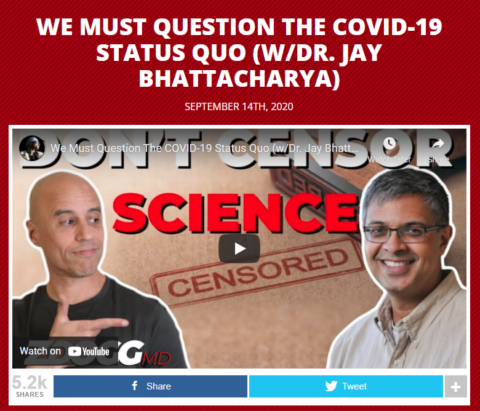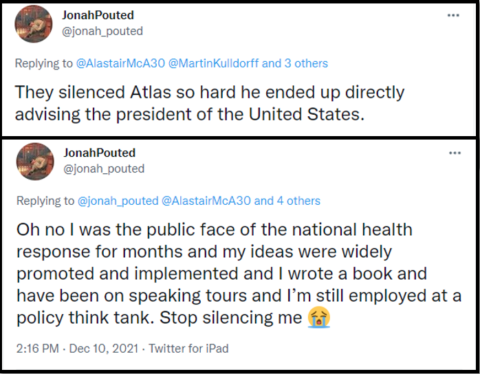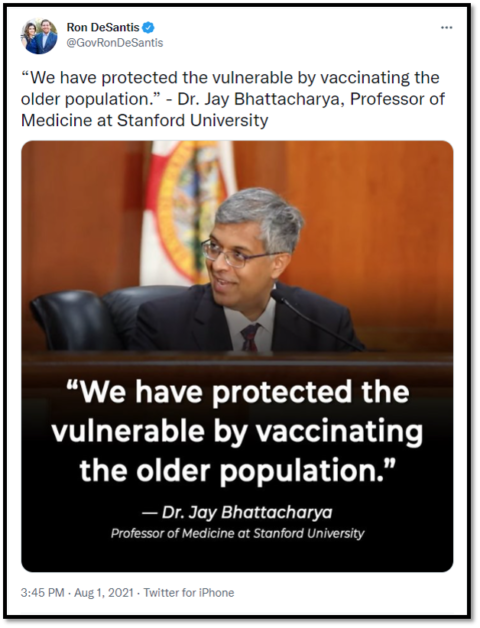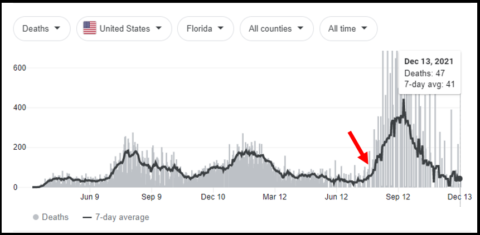A potential point of agreement
Supporters and opponents of the Great Barrington Declaration (GBD) are unlikely to agree on many things. I hope one area of agreement may be the following: The authors of the GBD are not invisible, muffled mystery men and women. People who pay attention to COVID-19 policy know their names, and we know what they believe.
In fact, these individuals are rather omnipresent figures in the COVID-19 media landscape. They have been on many large podcasts. They have given many TV interviews. They have been interviewed by and written many editorials in large newspapers. They’ve been profiled by The New York Times and Medpage Today. They have a large presence on social media. They have made a truly remarkable number of YouTube videos (Dr. Jay Bahattacharya, Dr. Sunetra Gupta, Dr. Marin Kulldorff), some of which have been seen by millions of people. They have testified before Congress and in courts regarding COVID-19 policy. Some have gained new funding sources or found new employment in right-wing think tanks. They’ve met with and influenced powerful politicians, such as Florida Governor Ron DeSantis. They held a “medical experts roundtable” at President Trump’s White House. Dr. Gupta met with and influenced UK Prime Minister Boris Johnson. Journalists rightly say they’ve become “famous voices” this pandemic.
Like I said, we know who the authors of the GBD are, and we know what they believe. Most importantly, we know how they’ve shaped our COVID-19 response.
“The question is whether the mainstream was right or wrong to try to muzzle them”
With this in mind, let’s consider the following passage from an article by Dr. Peter M. Sandman titled “8 Things US Pandemic Communicators Still Get Wrong.” He wrote:
There have been several patterns of fake consensus vis-à-vis COVID. The most dangerous is shutting up the dissenters, or bashing them so badly that potential followers shy away and they can’t get a fair hearing. The maltreatment of the Great Barrington Declaration authors comes to mind. The question isn’t whether they were right or wrong to oppose last year’s lockdowns; the question is whether the mainstream was right or wrong to try to muzzle them. Wrong, I think. Badly wrong.
This is a curious passage, though one the authors of the GBD would agree with. They’ve been on far-reaching podcasts claiming they’ve been “censored”. They’ve said the same thing on national TV programs. They’ve written editorials in international newspapers claiming they’ve been “muzzled.” They lament attempts to “censor and silence scientists” to their hundreds of thousands of Twitter followers. They even opened an Academy for Science and Freedom at Hillsdale College to counter “the silencing and censoring of scientists“.

This all raises some interesting questions. How can “muzzled” people be so loud? How can “censored” people be so ubiquitous? How have the GBD authors simultaneously been able to influence the country’s most powerful leaders and also been deprived of a “fair hearing”? Aren’t “silenced” people, supposed to be, well, silent? Have we completely abandoned the idea that words have meaning?
It seems the closest these individuals have come to being silenced is when YouTube removed a video of a “roundtable” discussion they had with Florida Governor Ron DeSantis. Maybe YouTube, a private company, shouldn’t have done this. It’s likely that removing the video amplified it’s reach (the Streisand effect), something the GBD authors almost certainly know. They certainly spoken about this video’s removal quite often. It seems to be a seminal moment of the pandemic for them, the same way seeing a 23-year-old die very early in the pandemic was for me.
Consider though that this video showed these individuals as they were setting COVID-19 policy for a state with 21.5 million people. Complaining about its removal is kind of like a lottery winner moaning that someone discarded the envelope that delivered his $20 million check. However, with hundreds of thousands of Americans already dead and hundreds of thousands of Americans still to die, it was the fate of this doomed YouTube video that really upset them. In a hissy fit of histrionics, Dr. Scott Atlas, said about this video:
There’s nothing more dangerous than being able to censor what is said in a country, because then you are simply not ever going to even hear the truth. And you are entering into a phase of countries that we used to criticize severely like the USSR, like communist China…I mean, this is almost the end of our civilization if we have this sort of censorship, I’m afraid.
Certainly, Dr. Atlas didn’t give the impression that academic freedom was actually a high priority for him when he threatened to sue his detractors at Stanford University, demanding they retract a letter criticizing him. However, I can’t put it any better than one Twitter commentator who wryly noted,

Criticism is not “silencing”
This lone YouTube video aside, it’s clear that Dr. Sandman and the authors of the GBD are conflating criticism with “silencing”. It’s a reflex for some people with enormous platforms to say they are being personally attacked or silenced when anyone quarrels with their ideas. Dr. Oz recently accused his critics of trying to “cancel me because of my strong conservative values“. Dr. Marty Makary, a ubiquitous media presence (book him yourself for $20,000 – $25,000) and superspreader of misinformation, wrote that “America’s self-anointed virus experts and social-media giants are silencing doctors with contrarian views“. Though it seems she’s been on podcasts and in the national media predicting the end of the pandemic for months on end, Dr. Monica Gandhi similarly lamented “The level of censorship and lack of tolerance for nuanced scientific discourse during this pandemic”.
If these individuals really consider themselves “silenced” this pandemic, does this mean that in their ideal world they would have made even more YouTube videos and been on more podcasts? It boggles the mind.
The Princess, the Pea, and the GBD
The attitude of the authors of the GBD towards criticism reminds me of the fairy tale “The Princess and the Pea“, in which a delicate princess slept poorly because a single pea with placed under a tower of mattresses. Except when it comes to young people dying of COVID-19, these are all very sensitive people.
For example, Dr. Gupta wrote a long article complaining that people used words she disliked when describing her ideas. She said,
Depressingly, our critics have also taken to ridiculing the Great Barrington Declaration as ‘fringe’ and ‘dangerous’.
But ‘fringe’ is a ridiculous word, implying that only mainstream science matters. If that were the case, science would stagnate. And dismissing us as ‘dangerous’ is equally unhelpful, not least because it is an inflammatory, emotional term charged with implications of irresponsibility. When it is hurled around by people with influence, it becomes toxic.
If my goal were to spare Dr. Gupta’s feelings, which substitutes for “fringe” and “dangerous” could I use to describe the notion that mass infection of young people is a desired outcome? I can think of many words, but few of them are more polite than these. After all, according to the CDC’s Covid Data Tracker, just under 6,000 Americans younger than 29 years have died of COVID-19 thus far, including over 1,000 children. Tens of thousands more children were sick enough to be hospitalized, some intubated in the ICU. The vaccine has been proven very effective in preventing these tragedies. “Dangerous” and “fringe” seem like fair words to describe those who encourage young people to contract the virus and oppose vaccinating children against it. However, out of respect for Dr. Gupta feelings, I will try to describe these ideas as “perilous” and “peripheral” from now on.
Similarly, Dr. Bhattacharya recently posted an email sent by NIH director Dr. Francis Collins who noted that the GBD authors had met with leading government officials in the Trump administration and requested a “quick and devastating takedown of its (the GBD) premises”. Dr. Bhattacharya called this a “propaganda attack by my own government“, and instead claimed to want “discussion and engagement”. What form might this discussion take if he feels it’s “a propaganda attack” when a public health official merely contemplates criticizing the premises of the GBD? Like I said, it’s a reflex for some people to say they are being personally attacked or silenced when anyone quarrels with their ideas. It’s almost as if Dr. Bhattacharya doesn’t really want “discussion and engagement” about the premises of the GBD unless his interlocutor is lavishing him with praise.
All of this this hypersensitivity to criticism is especially striking considering that the supposed attempts to “silence” the GBD authors and other COVID-19 contrarians have failed so miserably. It’s gotten to the point where if someone claims they have been “silenced,” I can generally make two predictions about them: 1) they’ve repeatedly underestimated and spread false information about COVID-19, and 2) they have a massive platform to loudly lament having been “silenced.”
Threatened, silenced doctors
There are some important exceptions to this. Dr. Li Wenliang, the Chinese ophthalmologist who bravely warned the world of COVID-19, was punished for speaking about the disease that would soon kill him. Dr. Nancy Messonnier and Dr. Rick Bright were silenced by the Trump administration for accurately stating the risks of COVID-19. In contrast to Dr. Bhattacharya, Dr. Jeffrey Goldhagen, a pediatrician at the University of Florida, was prohibited from testifying in a lawsuit regarding mask mandates in that state. Certainly, there are other people who were silenced, but we don’t know about them because they were actually silenced.
Additionally, the threats against prominent figures like Dr. Peter Hotez are outrageous and unacceptable. These vile behaviors are absolutely attempts to silence people, and a recent Nature survey showed that threats against scientists have become commonplace this pandemic. Countless health officials have quit their jobs because of abuse and harassment. This loss of expertise means we may be less prepared for a pandemic now than we were two years ago. As Dr. Gorski recently wrote about threats against Dr. John Ioannidis:
Let me just preface my comments here by saying quite unequivocally that having experienced harassment, death threats, and the like myself, I will always say that this is not acceptable, no matter how much I might disagree with the person experiencing them, period.
Amen.
However, some of the behavior that has been labeled as “threatening” doesn’t seem to rise to quite this level. For example, Dr. Jay Bhattacharya said that he felt threatened when posters were placed around his campus. These posters showed two images; a tweet sent on 8/1/2021 by Florida Governor Ron DeSantis with Dr. Bhattacharya saying “We protected the vulnerable by vaccinating the older population” and a graph of the massive spike in deaths in Florida that immediately followed this tweet. According to news reports, Dr. Bhattacharya felt “the poster campaign has been part of a larger attempt to keep him quiet.” At the risk of being accused of trying to silence Dr. Bhattacharya, I reproduced these images below.


Dr. Bhattacharya seems to have an odd relationship with the words of Dr. Bhattacharya. If he feels his own words can be paired with basic facts to silence or threaten him, maybe he should consider the real problem is with his words, not with anyone who shares them. I won’t say you are trying to threaten or silence me if you quote me and amplify my voice.
I think it’s important to share the words of people like Dr. Bhattacharya, and I plan to do this in my next article. I promise my aim is to discuss his thoughts on COVID-19, not to threaten or silence him. Moreover, even if I had this inappropriate goal, who really thinks that I, or anyone else, could actually accomplish it? Did the students who put up these posters really think he would be shamed into silence? If this was their plan, they utterly failed. Indeed, shortly after declaring Florida had protected vulnerable people, Dr. Bhattacharya said:
The emergency phase of the disease is over. Now, we need to work very hard to undo the sense of emergency. We should be treating covid as one of 200 diseases that affect people.
Maybe one day Dr. Bhattacharya will heed his own advice and treat COVID-19 as one of 200 diseases that affects people. I am willing to risk being accused of trying to “silence” him by admitting I look forward to that day.
Who is being silenced?
Ironically, all these melodramatic accusations of “silencing” are themselves likely to have a chilling effect on scientific discourse. I can understand why some people are reluctant to criticize the authors of the GDB. When well-funded, powerful professors with massive media exposure liken their critics to censors for the sin of posting their own words, this may frighten and silence anyone who dares to disagree with them in the future. When words like “dangerous” and “fringe” are said to be so “toxic” they stifle “coronavirus debate“, critics may feel the need to walk on eggshells to avoid offending the delicate sensibilities of those they disagree with. When potential criticisms of the premises of the GBD are labeled “propaganda attacks”, critics may decide it’s safer to say nothing. I’ve even seen contrarian doctors with large platforms pre-emptively lament that their hot takes will get them “cancelled” as a means of staving off criticism. After all, who wants to be accused of “censoring”, “harassing”, or “cancelling” someone else? It’s a cute trick.
Even though it’s a trick, it can be effective. A journalist who merely considered writing about doctors she felt had minimized the virus quashed her own article in part because an internet mob accused her of organising a “harassment campaign.” To her detractors, critical reporting equals harassment, and sacrosanct doctors are immune from criticism no matter how many facts they’ve mangled or how many times they declared the pandemic over. In the end, only this journalist was silenced by a “noxious harassment campaign“. Will the folks at the Hillsdale College Academy for Science and Freedom extend an invitation to her to rectify this outrage? I think we know the answer to that. Additionally, histrionic claims of censorship diminish the sacrifice of people like Drs. Wenliang, Messonnier, and Bright who actually paid a steep price for their candor. Acknowledging unpleasant truths sometimes requires bravery.
I hope some other people will be brave enough to acknowledge a few obvious truths. Silenced people are silent, and when the history of this pandemic is written, contrarian doctors divorced from patient care won’t be seen as its principal victims because YouTube removed their video, because someone called them “fringe,” or because someone put up posters reminding them of words they said.
Doctors who actually worked with COVID-19 patients know that others suffered much more.

